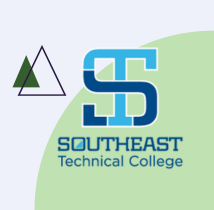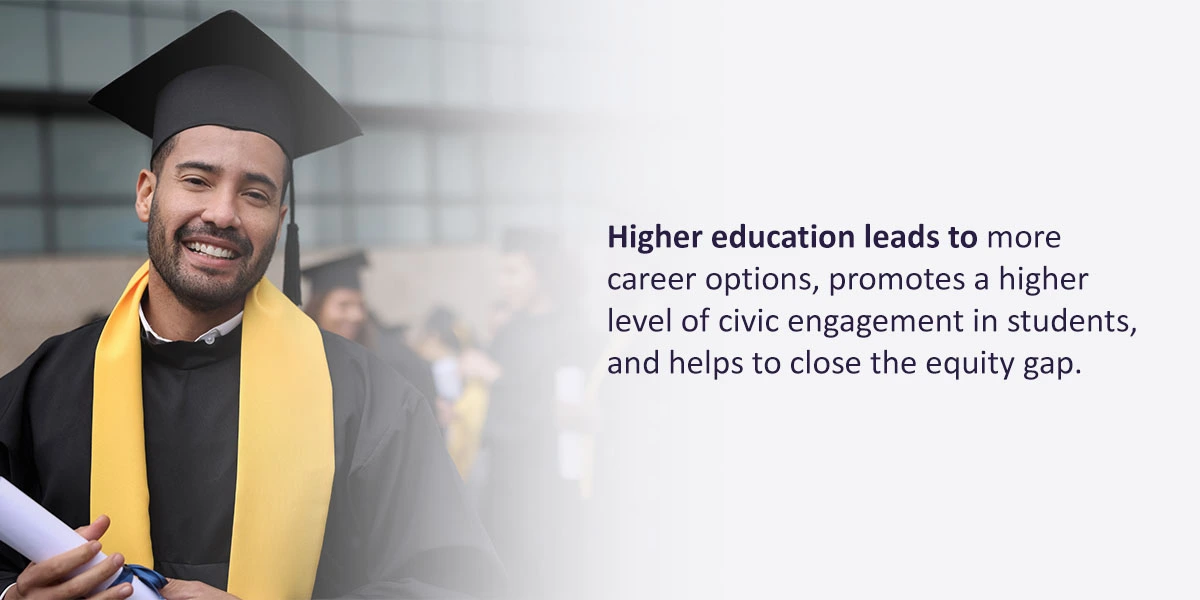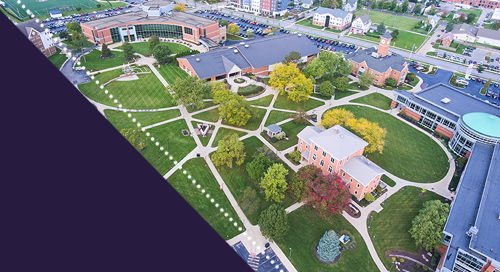
When planning for student success, the focus should be on keeping students enrolled at your college or university and ensuring they achieve their goals. This involves creating a supportive environment that helps students succeed academically, personally, and professionally.
In addition to providing assistance for students at risk of dropping out, higher education institutions must juggle financial pressures, changing demographics, and evolving job markets. Student retention and graduation numbers often relate directly to institutional reputations and funding. As an administrator, you want to ensure you effectively support learners throughout their academic journey. With a strategic planning process focused on student success, your organization can help individuals thrive beyond their time at your institution.
Learn how to introduce a comprehensive, long-term approach to student success that goes beyond traditional retention rate strategies with data-driven approaches.
The importance of student success strategic planning
Student success is the achievement of academic, personal, and professional goals throughout a student’s educational journey. It encompasses various outcomes that contribute to overall development and well-being, making it a top priority for higher education leadership teams. This holistic approach reflects positively on higher education institutions and indicates effective academic practices.
To measure student success, institutions typically assess factors such as:
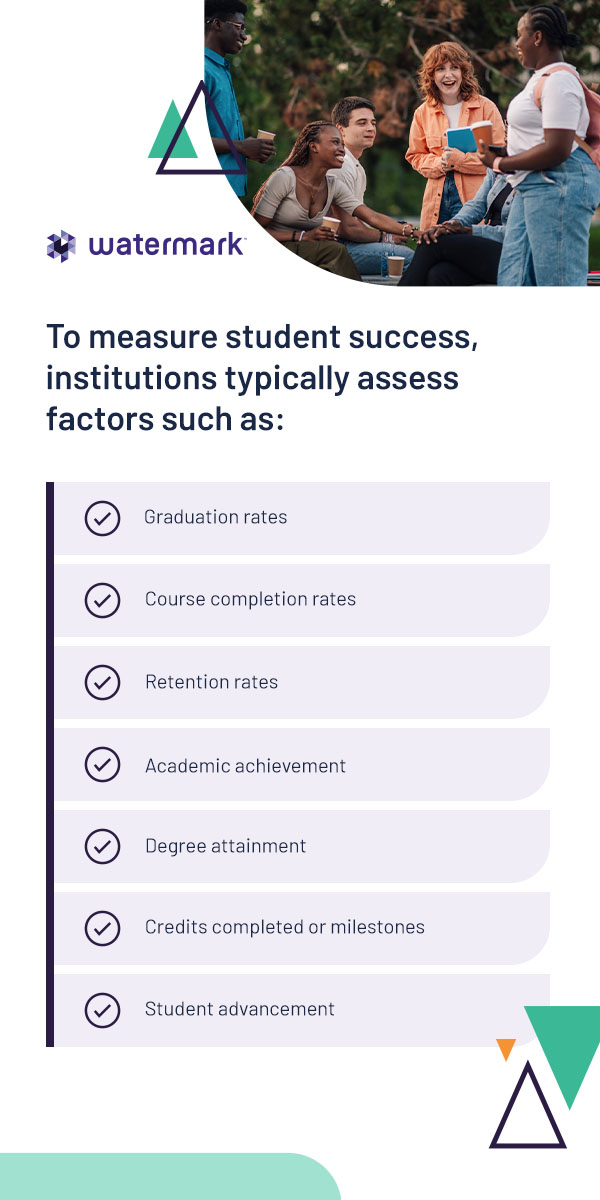
- Graduation rates
- Course completion rates
- Retention rates
- Academic achievement
- Degree attainment
- Credits completed or milestones reached
- Student advancement
Although these are easy numbers to track, student success extends beyond educational performance. It includes how students relate to peers, integrate into their communities, and access necessary resources — this requires colleges and universities to recognize who their students are on a personal level, what they expect from their experience, and where they seek support.
Students have unique and diverse definitions of success, which include personal development goals. Ultimately, fostering an environment that prioritizes student success involves acknowledging these multifaceted influences and creating tailored experiences that support holistic growth for today’s diverse and digitally savvy college students.
Student retention vs. success
Student retention and success are often discussed in the context of student affairs, although they represent different concepts and focus areas.
Student retention refers to the ability of an institution to keep learners enrolled from one academic term to the next until graduation. It focuses primarily on preventing student attrition and often includes the following interventions:
- Academic advising
- Financial aid support
- Identifying at-risk students
In contrast, student success includes a broader range of outcomes beyond keeping students enrolled. It recognizes that learners benefit from higher education by thriving in diverse ways:
- Further learning
- Personal development
- Progression into a career
Strategies include comprehensive support systems that address academic performance, mental health, community engagement, and career preparation.
The importance of career preparedness and lifelong learning
Higher educational institutions that prioritize student success through strategic planning are more likely to see sustainable improvements in student persistence and completion rates. When they demonstrate a commitment to learner success, they’re more likely to attract more prospective students and funding opportunities from an improved public perception.
Career preparedness and lifelong learning are critical components to implement in student retention strategies for the following reasons:
- Alignment with workforce needs: Career preparedness ensures graduates possess the skills and competencies today’s employers demand. Students can become more attractive job candidates when institutions align educational programs with timely industry needs.
- Adaptability in changing job markets: The modern workplace deals with rapid technological advancements and shifting job requirements. Lifelong learning fosters adaptability, enabling students to update their skills and knowledge throughout their careers. Encouraging a continuous learning mindset also helps develop resilience to navigate career changes and challenges.
- Competitive edge: Graduates who engage in internships, networking, and skill development workshops stand out in the job market. These career preparedness activities enhance their résumés and provide practical insights into their chosen fields. Those who pursue ongoing professional development demonstrate a commitment to growth.
- Job security: Continued skills development can lead to greater job security and earning potential over time. Lifelong learners become more valuable employees capable of adapting to workplace demands.
Creating a strategic plan for student success
Creating a strategic plan for student success requires collaboration among various stakeholders, data-driven decision-making, and a commitment to continuous improvement.
Keep the following tips in mind when creating your institution’s strategic plan:
- Recruit a diverse planning team and gather feedback from various stakeholders.
- Anticipate future trends in the educational landscape.
- Be specific with how you want to track progress.
- Ensure departmental strategies align with institutional plans.
- Implement your plan and review it regularly for areas of improvement.
Below is a step-by-step guide to developing an effective strategic plan.
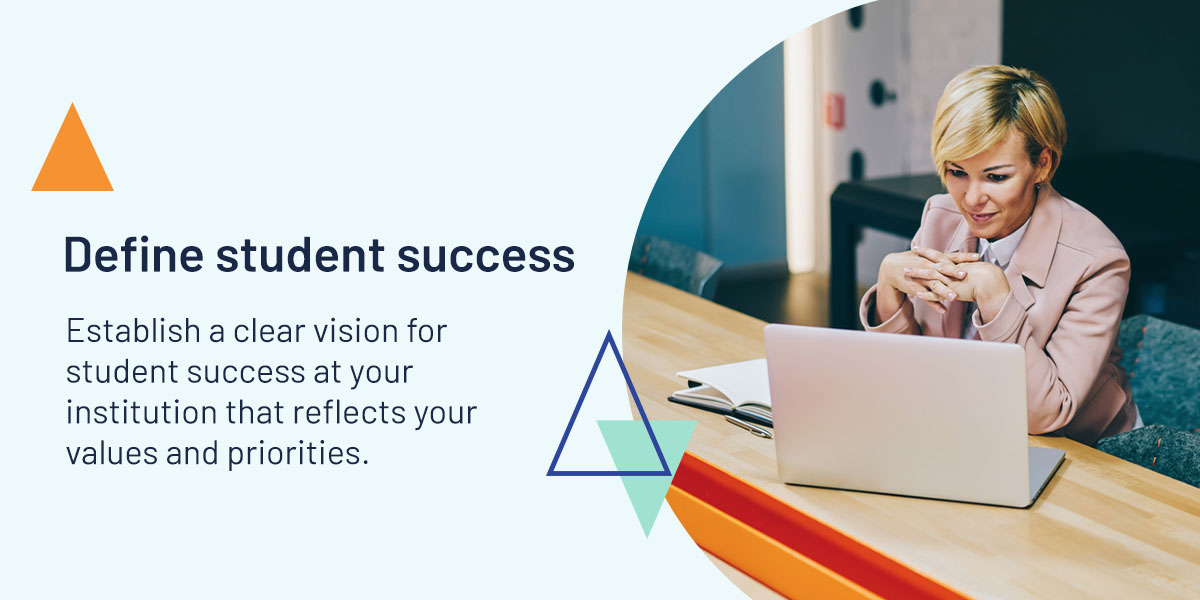
1. Define student success
Establish a clear vision for student success at your institution that reflects your values and priorities. Your vision should outline desired student outcomes. Your objectives for student success must align with your college or university’s broader mission and goals.
Students also need a clear vision to understand what you expect of them and the steps needed to achieve their goals. When students are unsure how to reach vague objectives, they may become discouraged, especially if they lack knowledge of available resources.
2. Connect with stakeholders
Form committees or working groups focused on different aspects of student success, such as academic support, career services, and mental health.
Involve key stakeholders from faculty, staff, administrators, students, and alumni in the planning process. Their different experiences and perspectives are invaluable in understanding student needs.
Your stakeholders can also provide valuable insight into curriculum and course design, ensuring your academic programs are relevant and flexible to suit diverse learners.
3. Conduct a needs assessment
Gather quantitative and qualitative data to assess current student outcomes, challenges, and areas for improvement. Analyze this data to identify gaps in services or support that may hinder student success.
Leveraging data modeling and analytics to anticipate student needs and drive data-driven decision-making can revolutionize your student success initiatives.
Higher education institutions now serve a diverse student population, including adult learners, part-time students, and full-time workers. Furthermore, prospective students seek value and a return on investment from their education amidst economic uncertainty. The following areas continue evolving in higher education:
- Program interests: Although many students still aim for bachelor’s degrees, others are increasingly interested in associate degrees, multiple credentials, or part-time options.
- Learning preferences: Learning preferences and styles vary widely among students. Personalized learning solutions with flexible scheduling alternatives may attract more prospective students.
- Technology: Technological advancements support various student types, such as transfers, commuters, and hybrid learners. Flexible learning arrangements, including hybrid and virtual options, can make degrees and certifications more accessible.
4. Develop comprehensive support systems
Determine what resources would be needed to implement strategies that will meet students’ needs. Every initiative will need a unique action plan, including:
- Academic support programs.
- Career readiness initiatives.
- Mental health resources.
- Community engagement opportunities.
- Peer-to-peer mentoring.
- Programs that address unique challenges by specific groups.
- Partnerships with local organizations.
5. Implement and monitor each goal
Develop a clear timeline for implementing each initiative and assign responsibilities to specific teams or individuals. Ensure all stakeholders understand the strategic plan and their roles in supporting student success.
Schedule regular strategic plan reviews to assess its effectiveness with stakeholder feedback. Use data tracking systems to monitor key performance indicators related to student success. Data is incredibly useful for supporting your institution’s learners, ensuring educators have the insights they need to tailor interventions and offer timely assistance.
How to implement student success initiatives
Implementing student success initiatives is an ongoing process that requires commitment from all levels of your university or college. Use the following steps to create a supportive environment that fosters student achievement and well-being.
1. Create a culture of success
Student success needs to start throughout the student’s whole journey, from their university application until graduation day.
Explore key elements of cultivating a culture of success below:
- Onboard effectively: Design comprehensive orientation programs with virtual components for incoming students to help them integrate into campus. You can create a targeted onboarding checklist that includes participation tracking and requirements students must complete.
- Build community and belonging: Focus on personalizing learning experiences and fostering a sense of belonging to improve retention rates. Your institution can achieve this by establishing strong community connections inside and outside the classroom. Encourage students to participate in class and campus activities to foster a balanced college experience. It will help students to feel valued and supported, regardless of their backgrounds.
- Foster a growth mindset: Teach students to adopt a growth mindset. Learning takes time, and all courses contribute to a student’s long-term success. Help them recognize and celebrate their wins along the way to maintain momentum.
2. Allocate proper resources
Ensure that the necessary resources are easily accessible to all students. Use the needs assessment to inform your decisions and consider the following:
- Personalized support: Learners may feel lost at large institutions. Make intentional efforts to understand your students’ backgrounds, strengths, and goals. Use a holistic approach and offer access to additional resources they may need outside the classroom.
- Ongoing engagement: Students require continuous support throughout their college journey. Advisors and mentors should proactively monitor learner progress and check in regularly to provide guidance as needed.
- Comprehensive student success plans: Strategic plans should encompass recruitment, retention, graduation, and equity gaps with career education integrated into the curriculum.
- Innovation and improvement: Foster a culture of innovation within your institution by implementing cutting-edge teaching methods and support services. You should also maintain a continuous improvement cycle to adapt strategies based on feedback and changing circumstances.
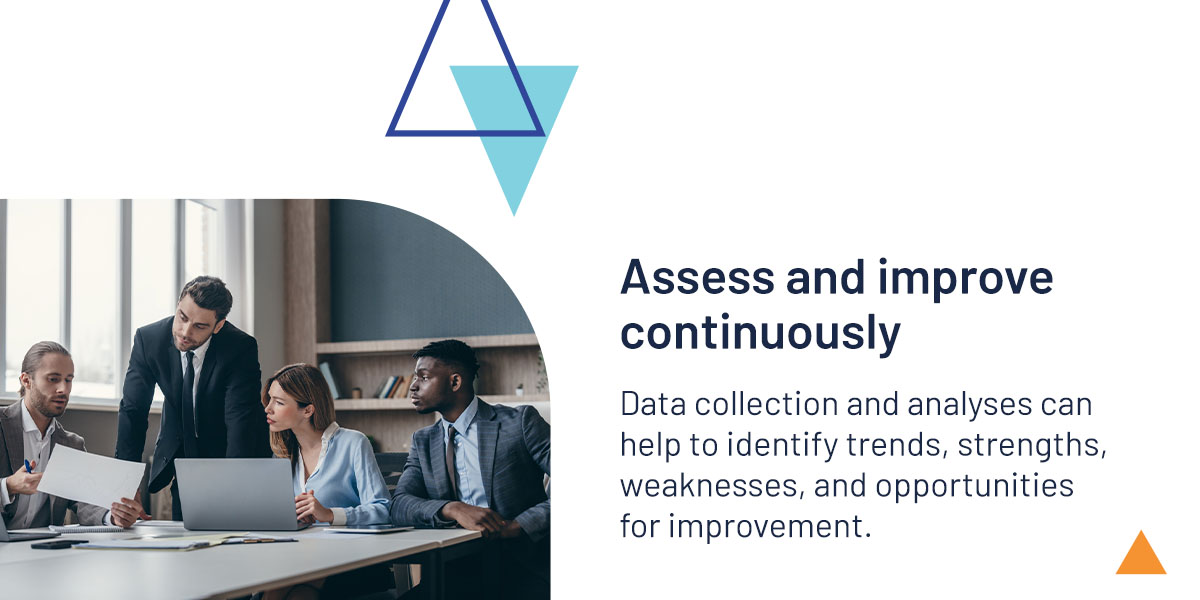
3. Assess and improve continuously
Remember that a strategic plan will need continuous updates and modifications as time goes on. Data collection and analyses can help to identify trends, strengths, weaknesses, and opportunities for improvement.
Here’s how you can use data to assess your strategic plan’s implementation:
- Enhance accessibility: Use technology and secure servers that allow students to access learning materials and streamline connections with advisors and support staff. Many programs have integrated meeting scheduler tools for easy access to support.
- Identify causes for interventions: Collecting data, such as class attendance and credit accumulation, can help your institution proactively identify and address at-risk students early. Automated alerts based on certain behavioral triggers and communication tools are also beneficial for following up with students who need assistance.
- Monitor success metrics: Data makes it easier to proactively address changing student needs and evaluate success metrics by adapting strategies based on evaluation findings.
4. Success metrics for higher education students
Success metrics used to be tracked by an institution’s first-year retention, graduation rate, and degree output. Today, universities and colleges need to incorporate several key metrics to assess students’ overall success as well balanced individuals. These insights may include:
- Academic performance: A common measure of a student’s academic performance across courses is the grade point average (GPA). Other metrics include retention, graduation, and course completion rates. These rates indicate how many students can meet academic requirements and complete their programs within specified timeframes.
- Engagement: Tracking class attendance is one indicator of student engagement and commitment to their studies. You can also monitor how often individuals use support services and whether they’re involved in sports, clubs, organizations, or volunteer activities.
- Career readiness: To see whether programs help students for their future careers, you can check graduates’ employment or internship status within a specific period after completing their degree. Also, monitor the number of learners accessing career counseling, resume workshops, job fairs, and networking events.
- Student well-being: Conduct surveys regularly to assess students’ overall satisfaction with campus life, engagement in activities, resources, and mental health.
- Diversity and inclusion: Analyze the diversity of the student body compared to local or national demographics to assess equity in access to higher education. Monitor performance metrics across different demographic groups to identify disparities in success rates.
- Financials: By tracking the percentage of students receiving financial aid, you can monitor the impact on retention and graduation rates and the average student debt upon graduation.
- Learning outcomes: Skill acquisition assessments may help to evaluate students’ mastery of key competencies related to their fields of study through capstone projects, portfolios, or standardized tests. Design assessments or rubrics to evaluate student work and improvements in critical thinking and problem-solving skills.
Using more than academic performance metrics enables your institution to gain valuable insights into student achievement, engagement, well-being, and overall success. A data-driven approach allows you to identify areas for improvement and implement targeted strategies that may enhance the educational experience for all students.
Request a demo of Watermark Student Success & Engagement
Planning for student success requires robust data collection and analysis. An education platform can streamline data gathering across various departments, allowing administrators to make informed decisions based on real-time insights into student performance, engagement, and outcomes. They can then identify at-risk students early and implement targeted interventions, moving beyond mere retention efforts to proactive support for student success.
With Watermark Student Success & Engagement, you can quickly create custom dashboards or reports, get early alerts when students veer off course, and collaborate with students to create a plan for success. Your platform can be customized to fit your institution’s unique needs, allowing for adaptable strategies that evolve with changing student demographics and academic landscapes.
Offer personalized support before students need it most. Request a demo today.
